Veg in the Spotlight: Celeriac – recipes from members
Following on from the Veg in the Spotlight last time, here’s some recipe inspiration from members for celeriac, a sometimes ‘hard to use’ root vegetable.
Thanks to Sarah Biddle for sharing a few of her tried and tested favourite celeriac recipes which she has posted in the Canalside Facebook group – accessible with this link:
Fennel & celeriac soup with orange zest from River Cottage
And 2 from Hugh Fearnley-Whittingstall’s book ‘Much More Veg’ (full recipe in the FB post)
Roast celeriac, shallots & dates with watercress
Red cabbage, celeriac & apple braise
Thanks also to Celia Russell for this one which she thought sounded delicious!
Pork belly with turnips, celeriac pakora and cauliflower toad in the hole: Ravinder Bhogal’s recipes for British winter veg from the Guardian
And you can find all the celeriac recipes from our recipe contributors over the years with this link.
Veg in the Spotlight: Celeriac
This week is the annual event that is the celeriac harvest, which means this staple root of the winter shares will be pulled from the ground, have some of its spindly roots trimmed off, and then be stored in a sand ‘clamp’ in the pole barn in the same way that the beets were recently. The damp sand protects the root veggies from winter frosts and prevents moisture loss which would reduce the quality of the veg.
‘Clamping’ is a traditional method for storing veg through the winter and is particularly used in regions where the winters are harsh and digging veg out of the ground is not possible for a large part of the winter. For us, a particularly cold winter would also put us in a position of not being able to harvest roots when we need them, and in a milder winter, the frosts we do get can still damage the tops of the roots meaning they would deteriorate in the field. The alternative frost protection for veg left in the fields is a thick layer of straw, but we’ve found that when we don’t get many frosts, the veg underneath starts to rot. It is also a useful storage method when the land needs to be turned to something else (though this doesn’t apply for us). As we are off-grid, traditional storage methods such as these are essential at Canalside to maintain the quality of the veg through the winter and into the spring: we don’t have access to the power/facilities needed for refrigerated storage, as would be used by the supermarkets and veg wholesalers.
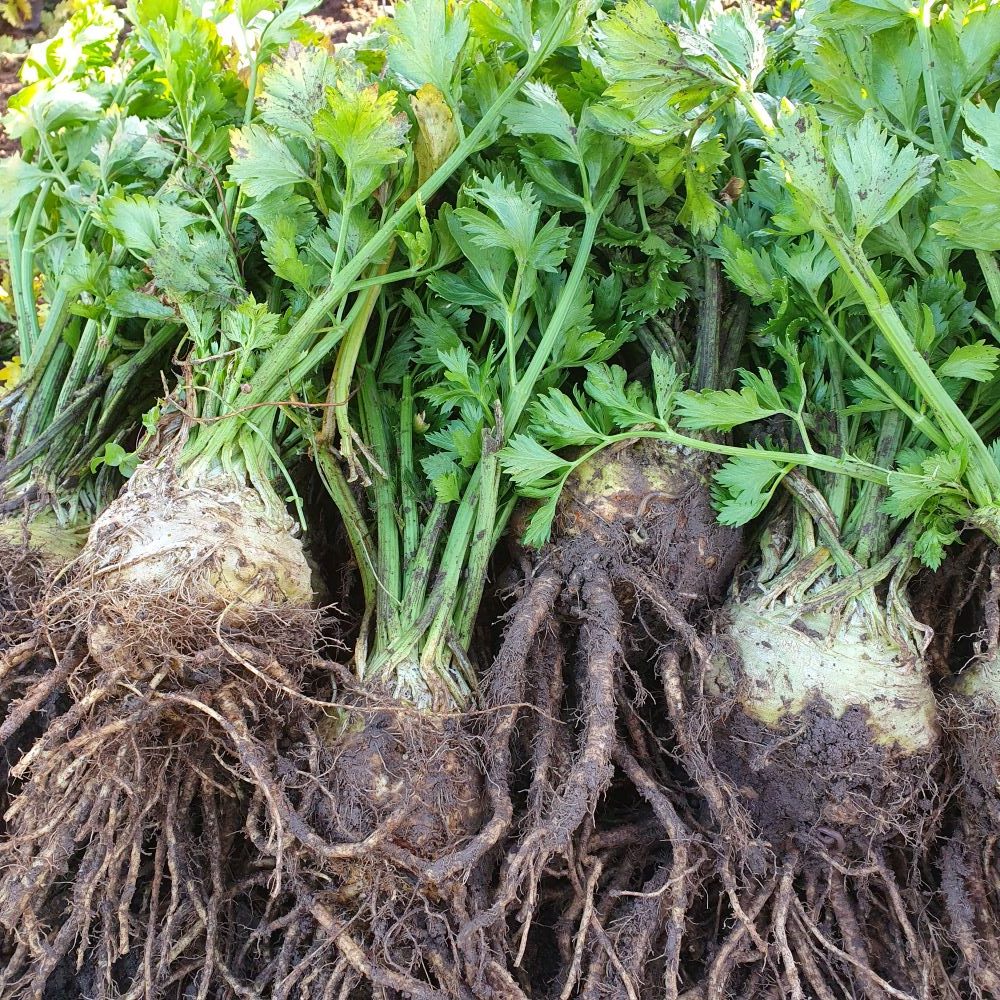
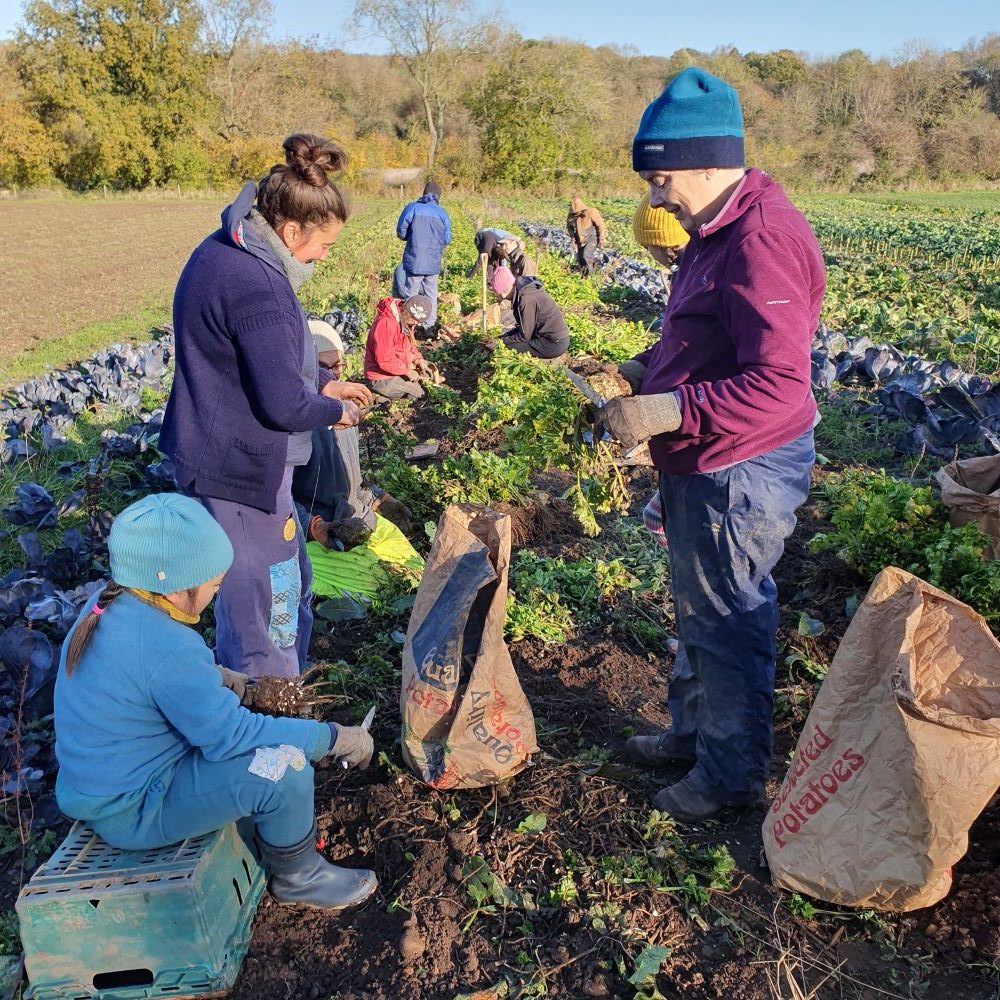
With a taste a bit like celery, some people can find celeriac difficult to use, but it’s a very versatile vegetable adding flavour from everything from soups and casseroles to gratins and salads (yes, it’s delicious raw – for example a grated celeriac salad in mayonnaise is a typical French dish that you will find in any charcuterie in France).
If you have any good recipes that you’ve tried and enjoyed, please add them to the Canalside Facebook group to help other members enjoy their celeriac shares this year. Then look out for a round up of recipes in the next news update in a couple of weeks.
Here are two to get you started, from the bank of recipes on the Canalside website:
Hasselback celeriac with miso and red onion
Celeriac pasta ribbons
And you can find all the celeriac recipes from our recipe contributors over the years with this link.
Veg in the Spotlight: Autumnal Greens
We’re coming into the season where different types of greens are once again going to make a more pronounced and regular appearance in the veg, now that the spell of frequent shares of mixed lettuce has passed. We’ll still be seeing lettuce from time to time. Check out the recipes suggested back in June if you need inspiration for using your lettuce. The greens we’ll be seeing more often again will include New Zealand spinach (already producing well and for a little while), chard and different types of kale (each with their own particular features: flat leaved, slightly sweet Red Russian kale, grass-green curly kale, dark green, mega iron-rich cavolo nero).
Known officially as tetragon, and having a large number of other nicknames, New Zealand spinach is a relatively recent addition to the range of veg grown at Canalside. It has a flavour and texture much like perpetual spinach (though the stems are more robust), and has the advantage of being great to grow in late summer and early autumn because it is much less prone to bolting (sending up a flower head and going to seed) in warm/hot weather.
Chard (also known as Swiss chard – with white ribs – and rainbow chard – with white/yellow/pink ribs) is somewhat like spinach/NZ spinach though it has a slightly earthier flavour and slightly more robust texture needing a slightly longer cooking time.
Kale is a member of the brassica (cabbage) family, so is full of vitamins, minerals and antioxidants. Brassicas are also the only fruit/vegetable source of glucosinolates, which are the sulphur containing compounds that have been linked to many health benefits including reduced incidence of some cancers. Cavolo nero is the most robust and is therefore ideal for heartier dishes and stir fried.
Any recipe that mentions any of these vegetables could use any of the others – you just might need to adjust the cooking time a bit and accept that the finished flavour may be slightly different if you have used a substitution. Below are some ideas that specifically mention the greens you can expect in your share in the coming weeks. They’re also perfect for adding to any daal, curry or stir fry recipe to up the nutrition and add a pop of green.
Recipes for New Zealand spinach are limited online as it isn’t a very widespread vegetable, although it seems to be growing in popularity in culinary circles! Here are some ideas which could give you some inspiration:
Japanese-Style New Zealand Spinach
Vietnamese-Style New Zealand Spinach
Here’s a very simple pasta recipe with few simple ingredients
From one German man’s bike travels in New Zealand, a gratin recipe
Braised NZ spinach with garlic (and some unusual/interesting ingredients to season it)
BBC Good Food has a delicious sounding array of recipes that use chard, including:
Chard, squash and parmesan tart
Swiss chard gratin
Chick pea and chard tamarind curry
Morrocan chard and lamb pan-fry
The River Cafe’s winter minestroni
There’s a wide range of recipes for kale with an international flavour, collated by Olive Magazine, which includes:
Kale crisps with smoky paprika sal
Sausage and lentils with cavolo nero
Kale, chilli and ricotta calzone
Kale hush puppies with lemon aïoli
Kale fiorentina pizzas
Plus a number of different salads using kale
As always, there is also a wealth of ideas in The Boxing Clever Cookbook (easily available secondhand for a few pounds) – 19 spinach recipes which could be made with New Zealand spinach, and 15 for curly kale, which could be adapted for other types of kale. Dips, bakes, risottos, sauces, daals and much more – it’s all covered in this one book for these greens. Interestingly there are none for chard!
For recipes for the different greens that Rebecca, Rob, Pip or guest contributors have tried and shared, go to the blog on our website here
https://www.canalsidecommunityfood.org.uk/about-canalside/blog/
or click on one of the links below
Spinach
Chard
Kale
If you have miscellaneous items to use in your fridge, and can’t find a recipe to match, you could try out the Oddbox Recipe Generator!
Veg in the Spotlight: Tomatoes
Now that the tomatoes have really got their growing vibe on, we’re getting a significant share of the harvest each week. This is where preserving comes into its own, to allow you to enjoy a taste of summer into the colder months. You can use any type of tomato, and there’s a hack below for reducing the liquid in salad/cherry tomatoes to make them better suited to cooking. However it’s worth looking out for the slightly oval shaped ‘Quadro’ to include as part of your share (we do encourage everyone to take a mix of types/sizes) – it is particularly well suited to sauces and pastes, and is a bit less watery/juicy and more pulpy.

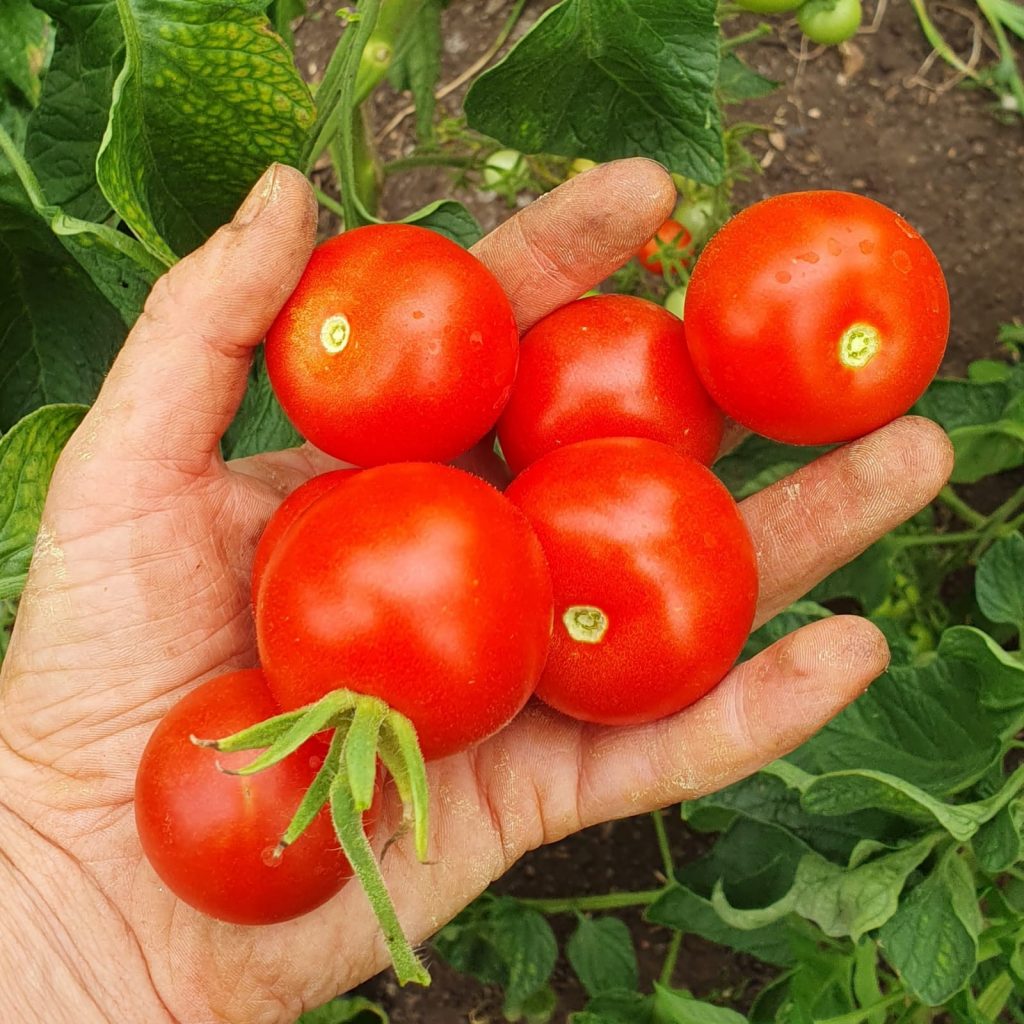

How to freeze (no blanching needed)
This simple method makes it really quick to freeze raw tomatoes, the skins can be removed easily after freezing and if you remove the liquid that comes out when they thaw it makes them better suited for cooking.
Another idea is to slow roast the cherry tomatoes you get and freeze them ready for a batch of risotto, soup or tomato sauce in the winter (no extra ingredients/water means they take up less space in the freezer).
Tomato sauce (can be frozen)
This recipe is an easy one for using plenty of tomatoes!
Tomato confit
This delicious sounding preserve extends the usability of your share of tomatoes as it will keep in the fridge for 2-3 weeks.
Greek briam
An oven baked version of ratatouille, Greek style.
Thanks to Erica Moody for these two suggestions.
Tomato skin powder
If you’re keen on an absolute zero waste approach in the kitchen, why not try making tomato skin powder from the skins you’ve taken off when making something else, to use as a seasoning. You can dry them in a low oven/put them in the oven after turning it off after each use. use a dehydrator, or even put them on racks on a sunny windowsill or in the sun in your greenhouse/conservatory/car. I found they dried well on a rack in my south-facing living room though haven’t yet had the time to convert them to powder for seasoning.
The book that makes a fantastic resource for this glut is How to Store Your Garden Produce: The key to self-sufficiency by Piers Warren. The 2008 edition has instructions for freezing, drying, bottling, juicing and recipes for several different preserves including the unusual ‘tomato butter’ (contains no butter) – a spiced and sweetened preserve. I did make it once, but decided to save my preserving energies for other things! It’s available cheaply, secondhand from online booksellers including World of Books and ABE books.
Drying (adapted from the book): dry in an oven, dehydrator, or if there’s very hot weather on a sunny windowsill/in a greenhouse/conservatory/car. Cut in half, tip off excess juice/liquid, lay on a drying rack (they probably need to sit on a plastic mat/mesh/rack as the acidity might not be great on a normal kitchen cooling rack) and sprinkle with a little salt. The drying process can take up to a day. For storing in a jar, remove when they feel firm and dry. For storing in oil, remove when still a little squishy, pack into sterilised jars and cover with oil before sealing. The book reckons you can keep them for up to 6 months stored in this way.
Here’s a recipe online for oil stored dried tomatoes. You can find others for drying tomatoes – mostly American though.
Juicing: If you have some kind of a juicer, tomato juice will keep for a day or two in the fridge. For longer enjoyment, put juice into freezer bags/zipbags and pack into empty tetrapaks. This way, once frozen they will stack neatly in the freezer without the carton.
And finally, tomato chutney is a great way to enjoy the flavours of summer months into the future. I find chutney generally keeps well for a year or more (I’ve eaten a good chutney 2-3 years after making and it’s still delicious). If you’ve never ventured into chutney making before, it’s an easy preserve to start with. The key things to be aware of are:
– follow the recipe approximately (ie. don’t double the recipe as this makes cooking it enough more of a challenge) – quantities can be flexed according to what you have but it’s a good idea to maintain about the right amount of produce for the quantity of sugar/vinegar
– be sure to cook it until a spoon drawn through it leaves a trail that doesn’t disappear immediately – getting impatient with this step will either cause it to catch and burn on the bottom of the pan due to too high a heat or have a consistency that hasn’t pulped down properly and has too much liquid. This in turn might make it not keep as well due to the ratio of vinegar in particular
– sterilise your jars in the oven at 160 deg C or until thoroughly dry (and lids, though they don’t tolerate the oven as well, so boiling may be better or a shorter spell in the oven)
Here’s a much used tomato chutney recipe from the book Basic basics, given to me years ago by Canalside founder, Tom Ingall.
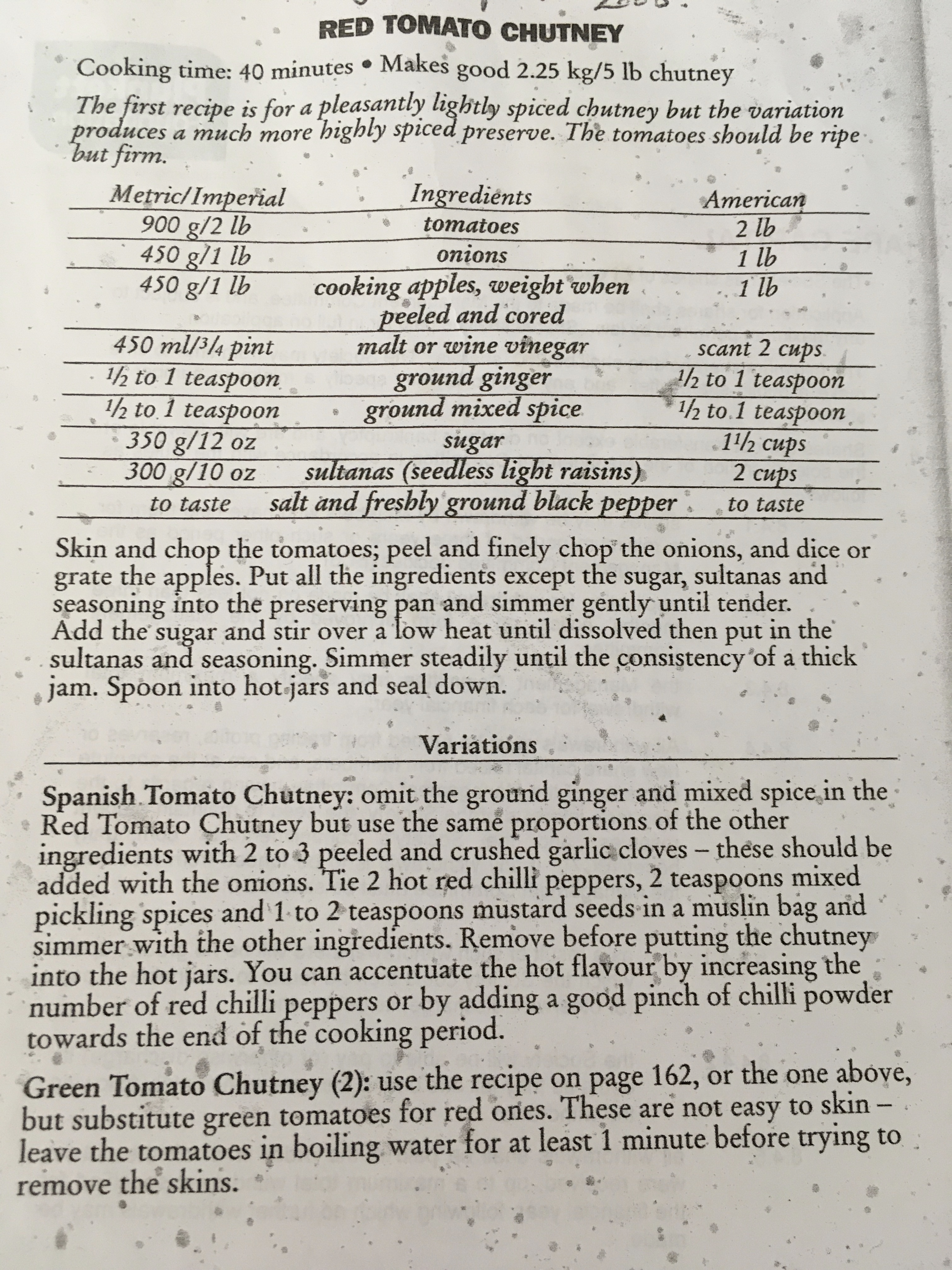
If you try any good recipes that other members might enjoy, why not share them on the Facebook group?
Fruit in the Spotlight: Currants
The pick-your-own offer for produce share members has been underway for a good few weeks now, and the current abundance is in currants with all three colours being ready for picking. The red and white currants (known in the Tudor period as jewel fruits on account of how they look) offer quick rewards as they’re best picked as ‘chandeliers’ – it’s not only easy to fill a tub this way but they also keep best left on the stalks (in a well sealed container in the fridge they may last up to a week or more!). They have similar flavours and are very closely related, although the whitecurrants are perhaps a little sweeter than the red ones. To strip the currants from the stalks, pull the stalk between the tines of a fork whilst held over a bowl.
However, inspite of the more laborious picking, where else can you get such deep, rich colour and tangy flavour in such plentitude as with blackcurrants? Your patience picking them individually from the bushes will reap you delicious rewards as they are an excellent fruit for making a wide variety of desserts and they also make a fine jam or jelly – the acidity means it should set very nicely.
If you haven’t yet managed any pick-your-own, we’d encourage you to visit the orchard during a collection time LINK soon to enjoy some of this jewelled deliciousness while it’s in season, along with blackberries, jostaberries and mulberries. (Don’t forget to check the board in the pole barn for which row to look in – taking a photo of the board is a good idea.) If you do manage that, why not try one of the recipes from the array below?
Hugh Fearnley-Whittingstall has you covered for all the currants in this article which shares recipes for:
Blackcurrant ripple meringues
Redcurrant and raspberry granita
Sausage and redcurrant salad
Summer pudding (one of the most versatile recipes for summer fruit as you can use whatever berries/currants you can get your hands on)
Redcurrants
Check out this selection of recipes for redcurrants that take you well past the ubiquitous redcurrant jelly. Redcurrant custard ripple sounds particularly easy and tasty.
Whitecurrants
Use whitecurrants in recipes for redcurrants, as a replacement for some or all of the redcurrants. Or try one of these delicious sounding recipes:
Whitecurrant jam
Whitecurrant tart – scroll down to find the recipe
Whitecurrant cake
Blackcurrants
Here you will find all the recipes for blackcurrants that you will ever need.
Breakfast
Cakes and cookies
Puddings and desserts
Frozen desserts
Preserves
Or a really simple (freezer-free) way to keep some of the taste of summer for later in the year, stew over a low heat until cooked with just enough water to stop them sticking, sweeten if you wish, and pot into sterilised jam jars (as for jam making) straight from the bubbling pot and screw the lid on straight away. The button will go in as the jar cools and you have a cupboard preserve ready for your winter morning’s porridge or a quick dessert with natural yoghurt or custard.
You can also use these soft fruits by themselves / with others to make fruit leathers.
Veg in the Spotlight: Courgettes
As courgette production ramps up, you may be finding you already need extra culinary inspiration to use a backlog of courgettes that are already accumulating in your fridge. It’s worth knowing that the beautiful yellow ones don’t keep quite as well as the green ones, so if you have picked up one of the golden gems, you’ll need to convert it into something delicious a bit more quickly than if you have only green ones.
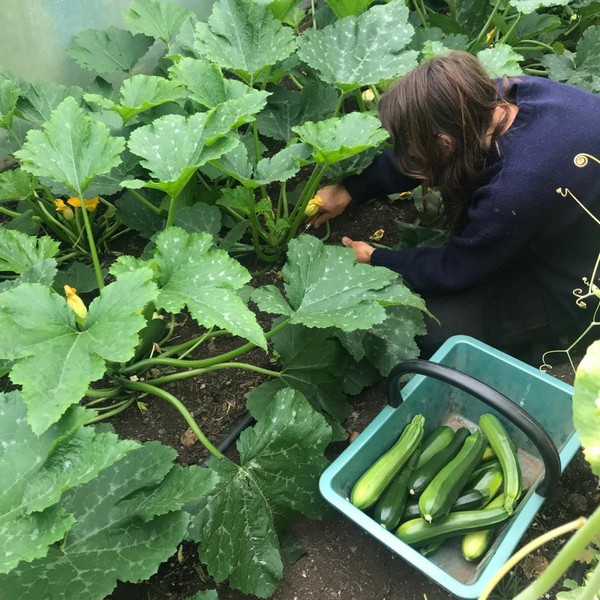
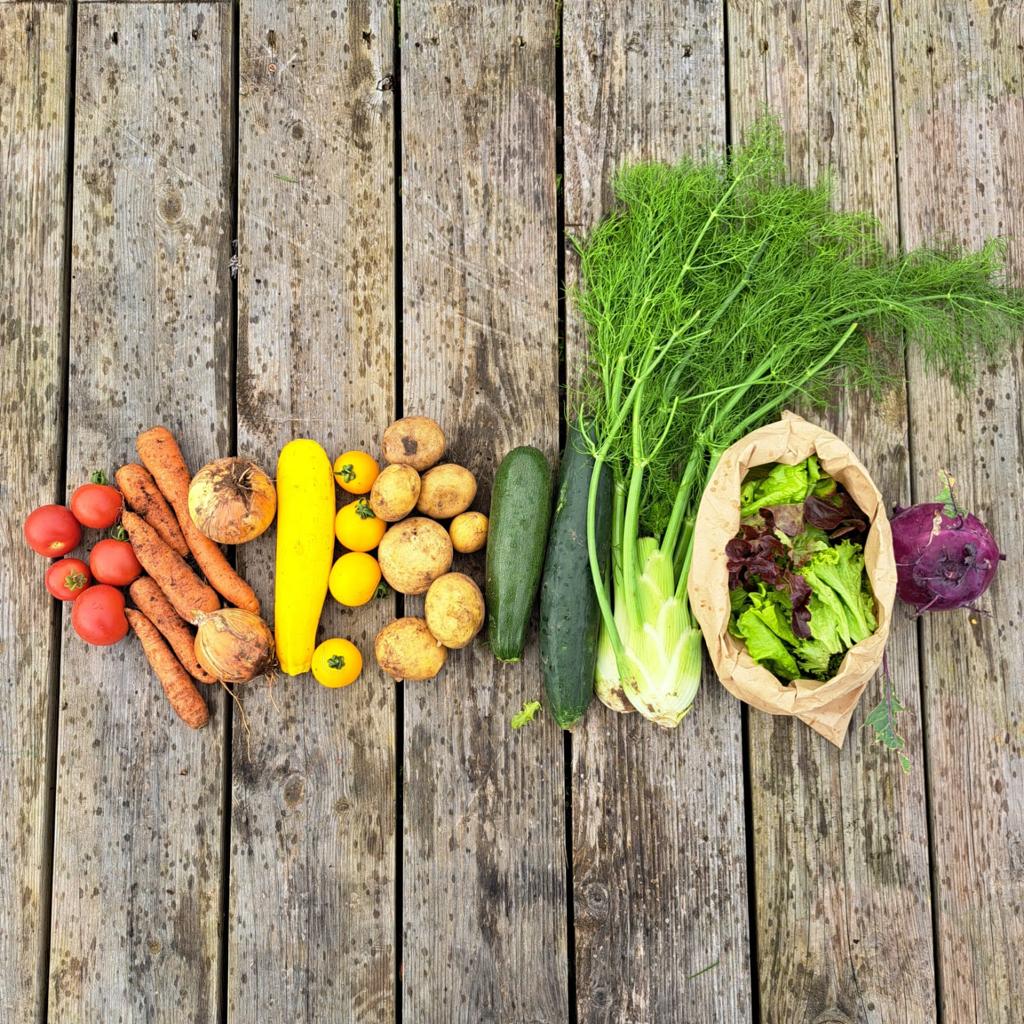
There is a multitude of courgette recipes on BBC Good Food which includes curries, chocolate brownies and a few different cakes, courgette fries, rataouille tart, soups, risottos, a gratin, pakoras and fritters, a pilaf, lasagne, a tempeh traybake (linking this one as I have some tempeh waiting in the cupboard for some inspiration to use!) and many more ideas!
In the past I’ve enjoyed Lemon Courgette Cake much like this one.
You could also try courgette and cheese mini breads or soda bread.
As always, there is also a wealth of ideas in The Boxing Clever Cookbook (easily available secondhand for a few pounds) – 14 courgette recipes to be precise! This includes recipes such as courgette, potato and coriander pie and courgette pate, as well as some more unusual sounding ideas such as courgette curry pancakes and courgette and cabbage crumble.
For courgette recipes that Rebecca has tried and shared, look here.
Veg in the Spotlight: Lettuce
With a significant amount of lettuce in the share as growth ramps up with the arrival of warm weather, it’s timely to share some inspiration for this summer share staple. The growers ‘cut and come again’ with our salad leaves as it allows us to keep cropping* the same plants until they bolt** ready to set seed*** later in the summer. We’re currently harvesting the first batch of outdoor lettuce. Later successions of sowings will mean we can keep harvesting lettuce right through until the end of the summer and into early autumn. This means that we can offer a mixed salad each week (currently including ‘Red’, ‘Paris de Blonde’, ‘Lollo Biondi’ and ‘Maravilla de Verano’) and we get the maximum produce from each plant for the least work.
*harvesting from
**send up a flower head
***make seeds for the next generation of plants
I remember really struggling to use all my salad in my first summer or two of Canalside produce, so until you’re ready to eat it by the handful straight from the bag (if that day ever comes for you!), hopefully some of these ideas will help you make the most of our summer leaves.
If you have a copy of the Boxing Clever Cookbook – the one cookbook I do go on about because it’s so useful for ideas and inspiration for using highly abundant seasonal veg – you’ll be able to find no less than 9 lettuce recipes! Eight of them can use loose leaves in the way we offer them, including 5 types of soup, lettuce and coconut chutney and lettuce risotto.
It also has a recipe for lettuce and walnut loaf – a sweet cake-like one with cinnamon and sugar. If you’re intrigued enough to try it, this seems to be the same recipe and here’s one using ginger and mace instead of cinnamon – a vintage 1968 recipe from the Kansas Wheat Commission.
Otherwise the following recipes can all be used with loose leaves, either whole or chopped:
Lettuce risotto with goat’s cheese from Delicious magazine – double tick as it would also use spring onions from this week’s share
Quick braised lettuce and peas from BBC Good Food
Garden salad, with a dressing recipe that also incorporates spring onion from this week’s share
If you eat animal protein, this dish might interest you:
Cod with bacon, lettuce and peas from BBC Good Food
There’s also an array of salad dressing recipes online of course – if you’d like to browse recipes for dressings that Rebecca has tried and shared, you’ll find them on the blog on our website here.
For recipes from Rebecca that would specifically use basil from the plants you collected recently, look here.
Veg in the Spotlight – Rhubarb


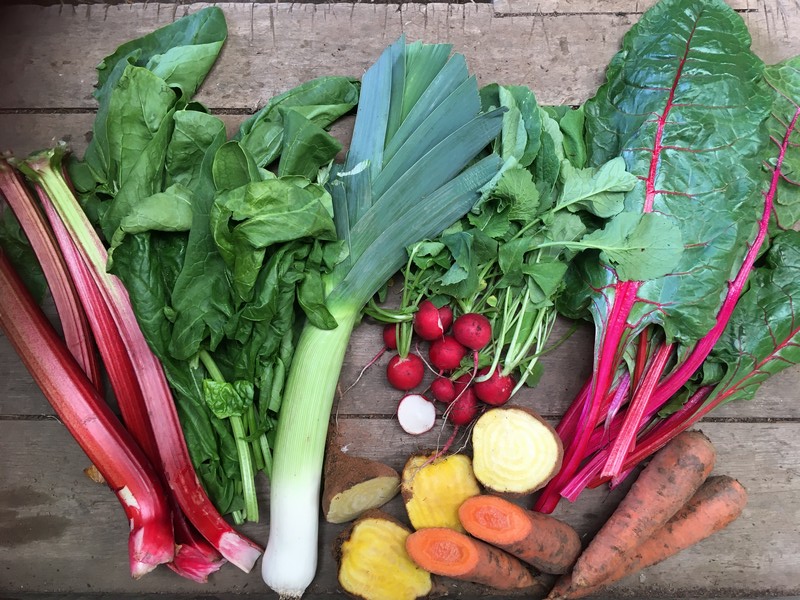
After its slow start to the year, the rhubarb is finally cropping well and arrived in the share this week with abundant measure! Knowing that it isn’t the easiest share item to use, the staff team put their heads together today to come up with some ideas for using your share.
Lena has fond memories of ‘rhabarber streuselkuchen’ (rhubarb crumb/crumble cake) from her childhood in rural Germany. Try this recipe.
Stephen’s top way to use it is as a compote, where the rhubarb is stewed with honey (you could also use chopped dates to sweeten, or of course sugar!). Ali likes to flavour a rhubarb compote with ginger (fresh if available, or dried) and/or orange juice and zest.
Nikki said she’s heard about rhubarb in curry, though she’s never tried it. Check out this recipe if you fancy giving it a go!
Other ideas from the staff team were:
Rhubarb cordial
Rhubarb ice cream (here’s a no churn recipe to try)
Rhubarb and custard (just like the traditional boiled sweet) using stewed rhubarb/rhubarb compote
Switch the last ‘Spotlight’s’ tarte tatin from onion to rhubarb.
This page from BBC Good Food has a wealth of ideas, from the classic rhubarb crumble, through delicious sounding rhubarb and custard scones and cardamon, rhubarb and ginger French toast traybake, to intriguing Russian shashlik with rhubarb sauce. And why not some rhubarb gin for a party later in the summer?! Plus a dozen more other ideas (the title lies – there are far more than 10 recipes!).
And if you have a copy of The Boxing Clever Cookbook (easily available secondhand for a few pounds) there are another 7 rhubarb recipes – including the more unusual rhubarb bread for bread making machine and rhubarb with lentils and potatoes. This book is a great resource for simple recipes for the classic vegetables of a seasonal box scheme, including loads of ideas for winter roots such as parsnips and swede (after all it was written by members of Earthshare CSA in Scotland!).
If you try any good recipes that other members might enjoy, why not share them on the Facebook group?
Ideas from yesterday’s staff team!
Veg in the Spotlight – Onions

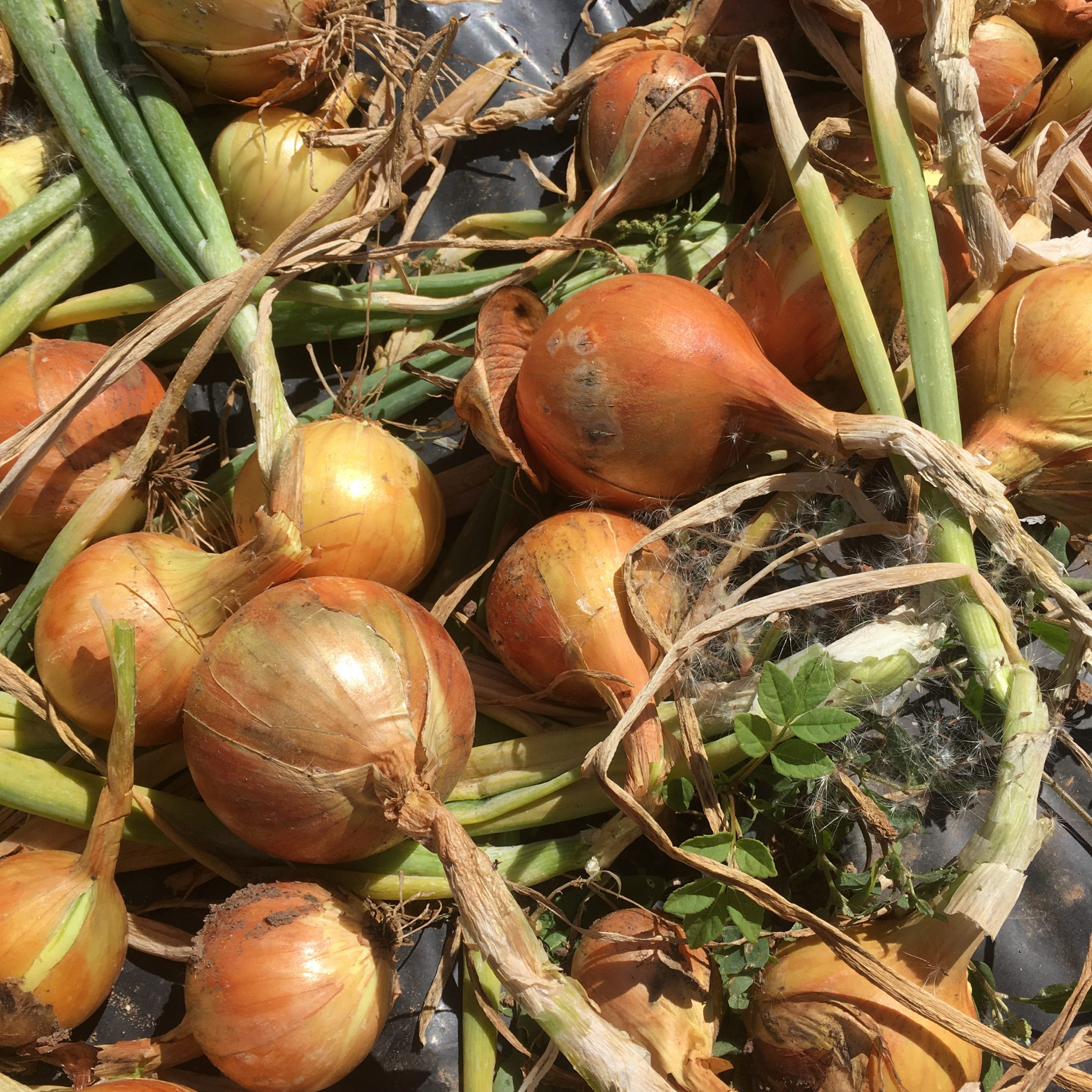

You may have noticed that the onions are beginning to be a little past prime condition as they have been in the store since last August: many are beginning to sprout in a bid to put in some growth this year, and we’re grading them carefully before each collection to try to ensure we only put out edible ones. As they won’t be usable for much longer, and the autumn planted onions in the field and spring onions are nearing readiness, the growers have increased the share of onions this week to 600g for a medium share – double what it’s been over the winter. We’re expecting another couple of weeks of last year’s crop.
So, what to do with this abundance of onions? Here are some ideas from Chef Lena, with a distinctly continental European flavour!
Fermented onions: turn them into a delicious condiment that softens the texture and the spiciness of raw onions – this blog post will tell you how.
Flammekueche: a Franco-Germanic version of pizza topped with onions, bacon and soured cream/creme fraiche. If you’re interested in the ins and outs of the perfect flammekueche, this Guardian article can oblige. If you just want the recipe, scroll down quite a way, or seek out a different website!
Tartiflette: similar to flammekueche without the pastry/bread base and with the addition of cheese, from the slightly more northern French region of Haute Savoie – try this BBC Good Food recipe for it.
French onion soup: you’re spoilt for choice when in comes to recipes for this classic soup which needs plenty of onions – it could easily use 2-3 weeks’ worth of shares (depending on your share size). This one makes a grand claim – see what you think!
Tarte tatin aux oignons: another classic, though tarte tatin more commonly made with apples. Why not give Jamie Oliver’s recipe for a version with onions a go?
Text from Ali, ideas from Lena
Veg in the Spotlight – Leafy tops
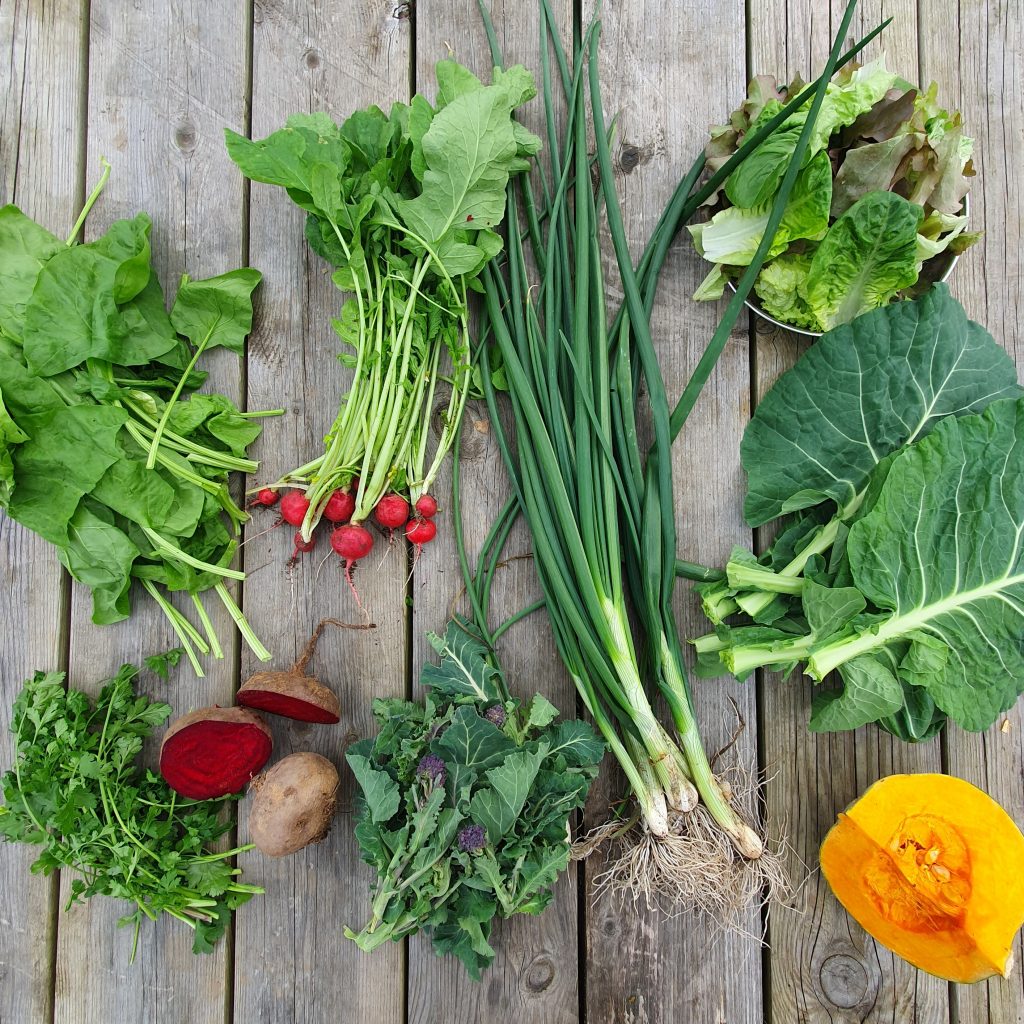
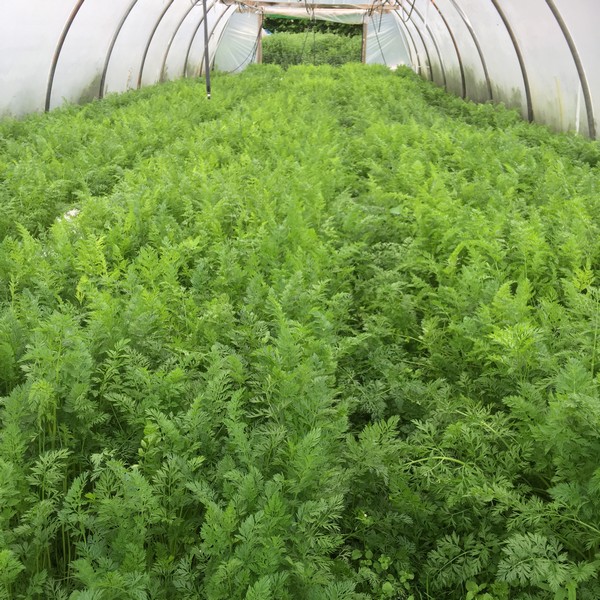
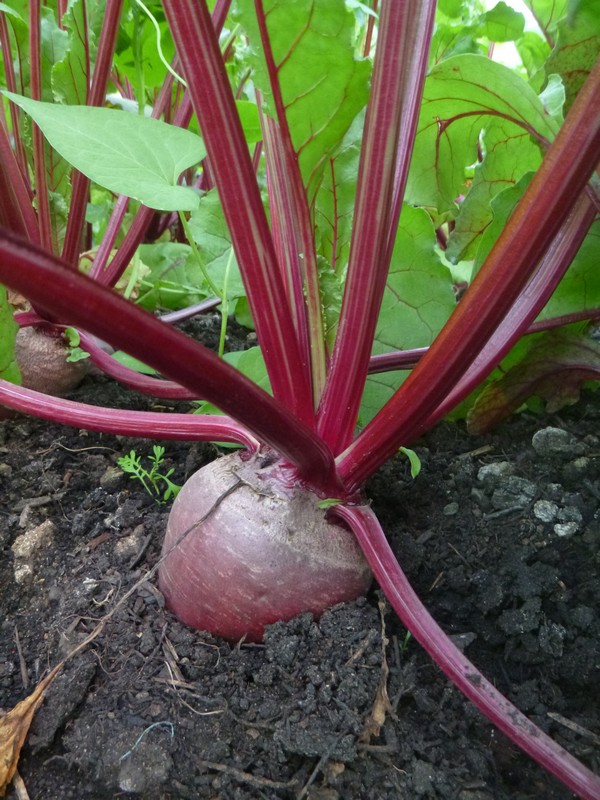
We’re coming into the time of year for the earliest crops and, especially where they are roots, the young tender leaves can be as much an ingredient as the root veg. This is why we include them in the weight of the share – you will take the roots with any attached leaves in the weight for your size of share and get 2 share items in one!
Here are some insights about what might be coming in the share and ideas for how to make the most of all the edible parts. As a general rule, they all work well added to/as a basis for pesto, and in hummus, as well as like other greens in soups, stir fries and smoothies.
Radish tops:
As appeared in the share this week
The slightly rough/prickly texture on the surface of the leaves is lost with cooking
Try:
Chopped and used in stir fries, soups etc, as for any other green
One of the 5 ways suggested here
Carrot tops:
Will be in the share on the first baby carrots
Try:
Carrot top pesto
Roasted baby carrot and grain salad with carrot top dressing
More ideas and recipes here
Beet tops:
Similar to chard
Come with the first baby / early season beetroots
Try:
Braised beet tops with lemon juice
A number of ideas from Oddbox
Fennel tops/fronds:
Basically dill, and always plentiful on our fennel bulbs!
Try:
One of the 10 ways suggested here including in a pesto and salads, as a herby flavouring, in juices and curries
Celery tops:
Full of flavour and a great ingredient for a variety of uses
Try:
One of the 5 ways suggested here including in soups, to flavour salt and in a pesto
Ideas from Ali